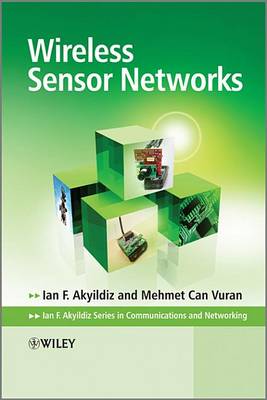Advanced Texts in Communications and Networking
2 primary works • 3 total works
Book 3
Going beyond classic networking principles and architectures for better wireless performance Written by authors with vast experience in academia and industry, Wireless Mesh Networks provides its readers with a thorough overview and in-depth understanding of the state-of-the-art in wireless mesh networking. It offers guidance on how to develop new ideas to advance this technology, and how to support emerging applications and services. The contents of the book follow the TCP/IP protocol stack, starting from the physical layer. Functionalities and existing protocols and algorithms for each protocol layer are covered in depth. The book is written in an accessible textbook style, and contains supporting materials such as problems and exercises to assist learning.
Key Features: Presents an in-depth explanation of recent advances and open research issues in wireless mesh networking, and offers concrete and comprehensive material to guide deployment and product development Describes system architectures and applications of wireless mesh networks (WMNs), and discusses the critical factors influencing protocol design Explores theoretical network capacity and the state-of-the-art protocols related to WMNs Surveys standards that have been specified and standard drafts that are being specified for WMNs, in particular the latest standardization results in IEEE 802.11s, 802.15.5, 802.16 mesh mode, and 802.16 relay mode Includes an accompanying website with PPT-slides, further reading, tutorial material, exercises, and solutions Advanced students on networking, computer science, and electrical engineering courses will find Wireless Mesh Networks an essential read. It will also be of interest to wireless networking academics, researchers, and engineers at universities and in industry.
Key Features: Presents an in-depth explanation of recent advances and open research issues in wireless mesh networking, and offers concrete and comprehensive material to guide deployment and product development Describes system architectures and applications of wireless mesh networks (WMNs), and discusses the critical factors influencing protocol design Explores theoretical network capacity and the state-of-the-art protocols related to WMNs Surveys standards that have been specified and standard drafts that are being specified for WMNs, in particular the latest standardization results in IEEE 802.11s, 802.15.5, 802.16 mesh mode, and 802.16 relay mode Includes an accompanying website with PPT-slides, further reading, tutorial material, exercises, and solutions Advanced students on networking, computer science, and electrical engineering courses will find Wireless Mesh Networks an essential read. It will also be of interest to wireless networking academics, researchers, and engineers at universities and in industry.
Book 5
This book presents an in-depth study on the recent advances in Wireless Sensor Networks (WSNs). The authors describe the existing WSN applications and discuss the research efforts being undertaken in this field. Theoretical analysis and factors influencing protocol design are also highlighted. The authors explore state-of-the-art protocols for WSN protocol stack in transport, routing, data link, and physical layers. Moreover, the synchronization and localization problems in WSNs are investigated along with existing solutions. Furthermore, cross-layer solutions are described. Finally, developing areas of WSNs including sensor-actor networks, multimedia sensor networks, and WSN applications in underwater and underground environments are explored. The book is written in an accessible, textbook style, and includes problems and solutions to assist learning.
Key Features: * The ultimate guide to recent advances and research into WSNs * Discusses the most important problems and issues that arise when programming and designing WSN systems * Shows why the unique features of WSNs self-organization, cooperation, correlation -- will enable new applications that will provide the end user with intelligence and a better understanding of the environment * Provides an overview of the existing evaluation approaches for WSNs including physical testbeds and software simulation environments * Includes examples and learning exercises with a solutions manual; supplemented by an accompanying website containing PPT-slides. Wireless Sensor Networks is an essential textbook for advanced students on courses in wireless communications, networking and computer science. It will also be of interest to researchers, system and chip designers, network planners, technical mangers and other professionals in these fields.
Key Features: * The ultimate guide to recent advances and research into WSNs * Discusses the most important problems and issues that arise when programming and designing WSN systems * Shows why the unique features of WSNs self-organization, cooperation, correlation -- will enable new applications that will provide the end user with intelligence and a better understanding of the environment * Provides an overview of the existing evaluation approaches for WSNs including physical testbeds and software simulation environments * Includes examples and learning exercises with a solutions manual; supplemented by an accompanying website containing PPT-slides. Wireless Sensor Networks is an essential textbook for advanced students on courses in wireless communications, networking and computer science. It will also be of interest to researchers, system and chip designers, network planners, technical mangers and other professionals in these fields.
Cognitive Radio Networks
by Ian F. Akyildiz, Won Yeol Lee, and Kaushik R Chowdhury
Published 9 December 2009
Cognitive Radio Networks: Theory and Applications provides an in-depth view of the principles and design constraints for both infrastructure-based and distributed cognitive radio networks. In addition, the book includes a discussion on the basic principles as well as advanced topics that govern cognitive radio operation in a dynamic spectrum environment. Furthermore, the authors address both the underlying theoretical aspects of dynamic spectrum utilization enabled by cognitive radio, and provide practical industry solutions that are being implemented. Divided into four parts this book contains: 1) Cognitive Radio (CR) Networks: Overview (physical architecture of CR, network architecture), 2) Spectrum Management for Cognitive Radio Networks (CR cycle), spectrum sensing, spectrum decision, spectrum sharing, and spectrum mobility), 3) Protocol Design in Cognitive Radio Networks (medium access control protocols, routing algorithms, transport protocols, cross-layer design issues), 4) Standards and Testbeds (standards, testbeds).


